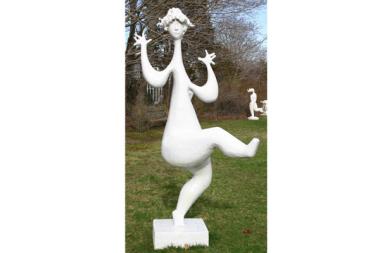The carnival clown poked fun at my glasses and suggested that my strongest muscle is the one I use to control the computer mouse.
Goading patrons is his job: pay $5 and you get three balls to pitch at a target which, when hit, launches the clown into a dunk tank. The more he gets under your skin, the more you want to knock the clown off his chair. I left humiliated and $10 poorer.
That was three summers ago. A year later, I obtained sweet revenge when I dispatched the clown with a laser-accurate second shot. I decided to quit while I was ahead; last year, on my third visit to the Martha's Vineyard Agricultural Fair, I spoke with my one-time nemesis instead of chucking balls at him.
"If you play the game, I assume you know what to expect," says Tom the Clown about his sharp verbal jabs. A resident of rural Maine during the off-season, Tom is a 12-year veteran of the carnival circuit. He makes it a point to insult only paying customers. "I don't give it away," he says. Carnival clowning is tough work; Tom must maintain a nonstop patter of snappy insults, and can get dunked well over a hundred times on a busy summer day.
"Fairs are fairs," says Tom, but notes of the Martha's Vineyard version, "It's an interesting collection of people from all over the world." And they're brighter than most. "They get the jokes," Tom says.
The 146th edition of the Martha's Vineyard Agricultural Fair, or Ag Fair, will be held this August 16-19 in the village of West Tisbury. The Fair is pretty much mandatory for locals, and is a big draw for visitors, whether they are on the Vineyard for the day or are spending the summer.
Dunking the clown, shooting baskets to win a stuffed Homer Simpson and losing your lunch on a ride are just a small part of the fair experience. At the heart of the Ag Fair are displays on farm life, and contests judging critters ranging from chickens to alpacas to bulls. There are also competitions and demonstrations that pay homage to the area's rural past, including a woodsman competition, a draft horse pulling contest, and the women's skillet throw.
Bob Woodruff, 71, is a conservationist, environmental consultant and gentleman farmer who has lived on the Vineyard for almost 40 years. For the last several years he has brought his team of oxen to the fair, using them to clear logs felled in the tree chopping contest.
"Oxen were the tractors on the Island and in New England before horses became common in the 1860s," says Woodruff, who also notes that the powerful beasts were instrumental in constructing many of the stone walls found on the Vineyard.
The current incarnation of the Vineyard Ag Fair blends old and new: in the morning you can watch goats being judged, and in the afternoon take in a hip hop demonstration. At night there are concerts, and naturally there's plenty to eat throughout the day.
West Tisbury comprises a good chunk of the western portion of Martha's Vineyard, and includes the port town of Vineyard Haven. While West Tisbury is sizeable, the village of West Tisbury is little more than an intersection. Located a few minutes west of the Ag Fair site, it retains the features of a colonial New England town with its church (whose congregation dates to 1673), general store, town hall, library, and multipurpose Grange Hall.
The Grange Hall, the Ag Fair's former home, was constructed in 1859. On different days of the week during the summer it hosts an artisan festival, an antiques show, and a farmer's market. The artisan festival is a juried affair—there are no cheap T-shirts or schlocky knick-knacks dragged in from off-island.
Of course, Tom the clown is an artist in his own right. It's just that his work—which could be described as an interactive performance piece—is on display at a fairgrounds, not a gallery. In any case, both Tom and his more highbrow artistic brethren are essential to West Tisbury, a decidedly mellow slice of the Vineyard."



